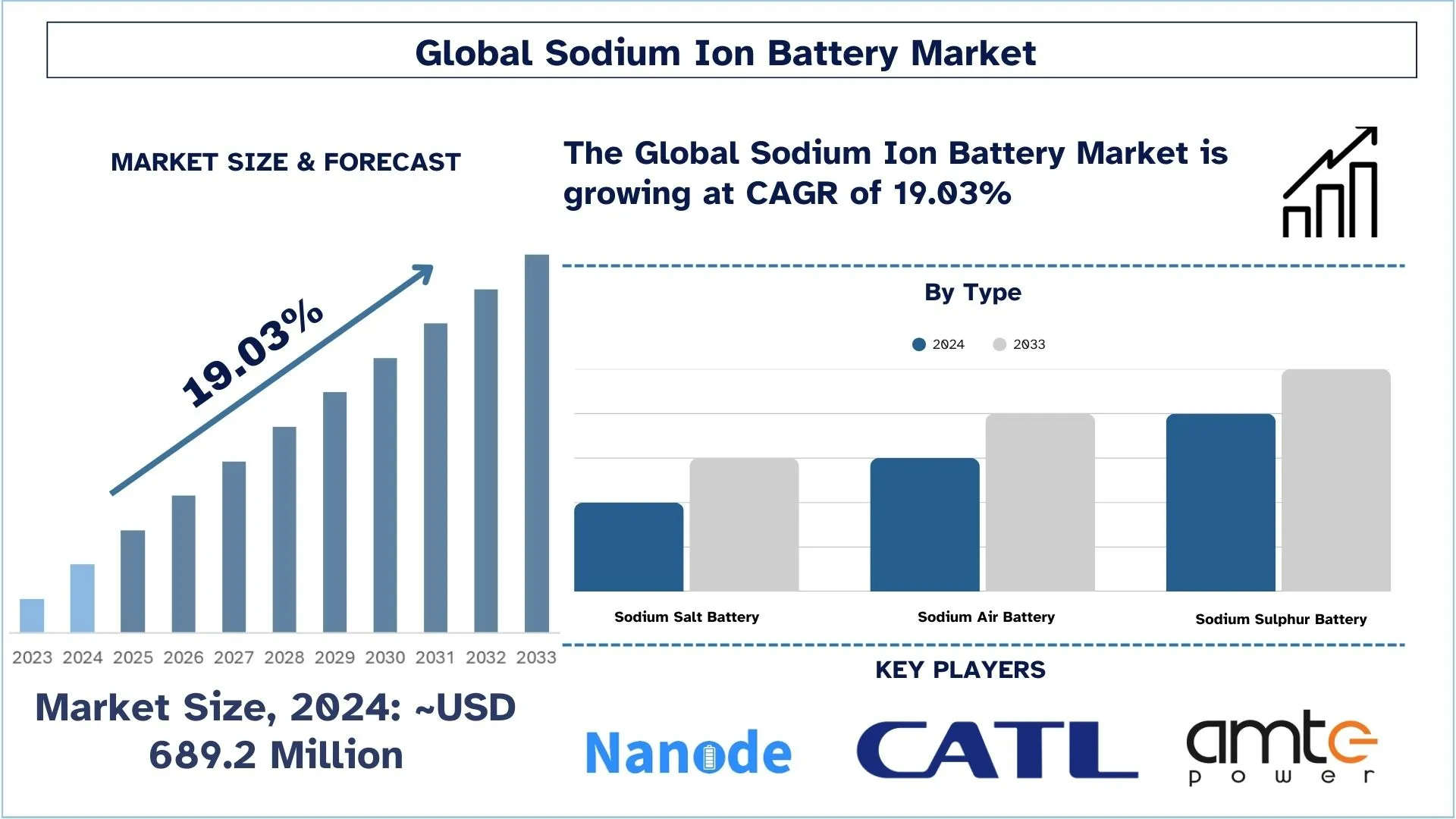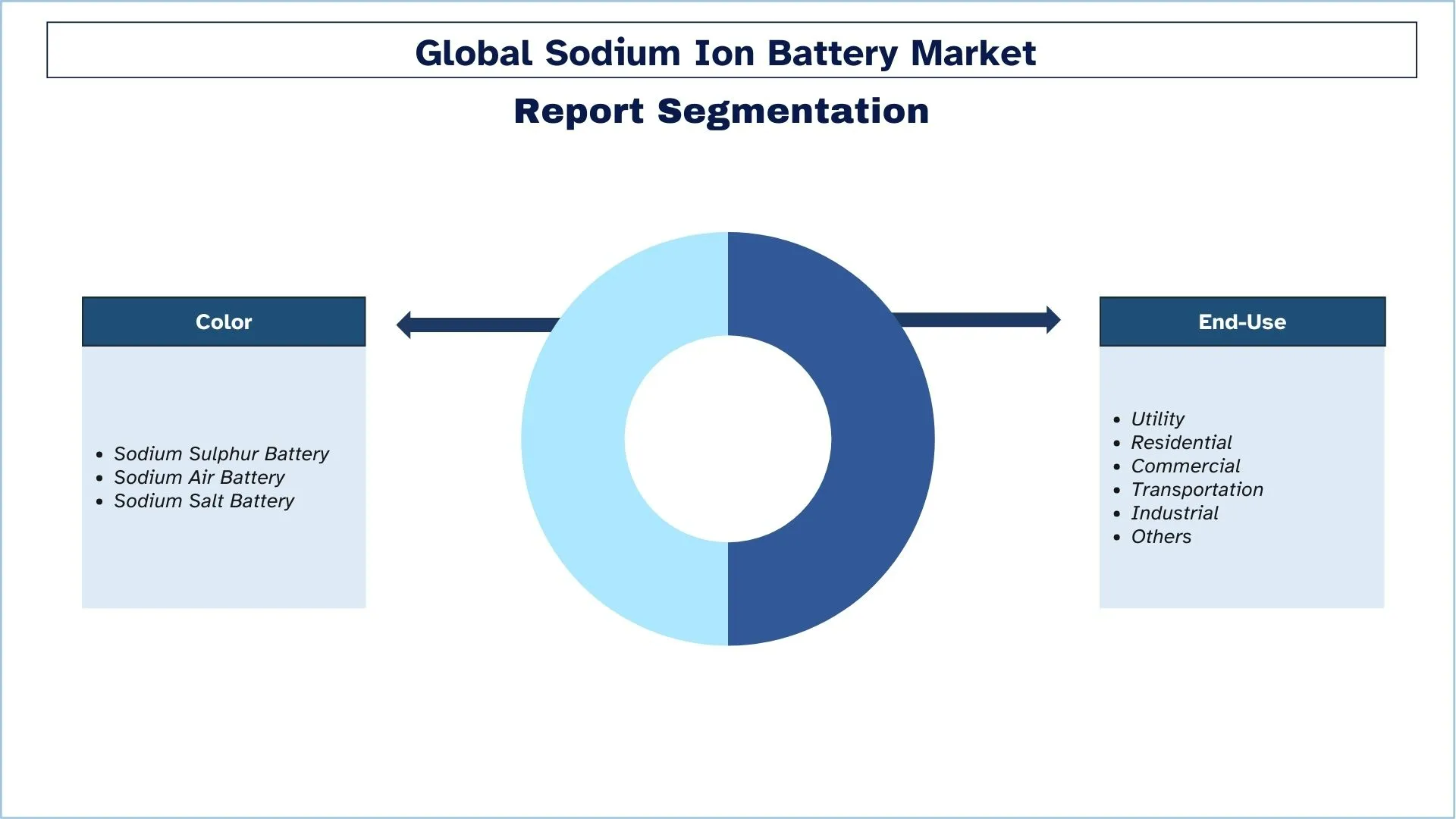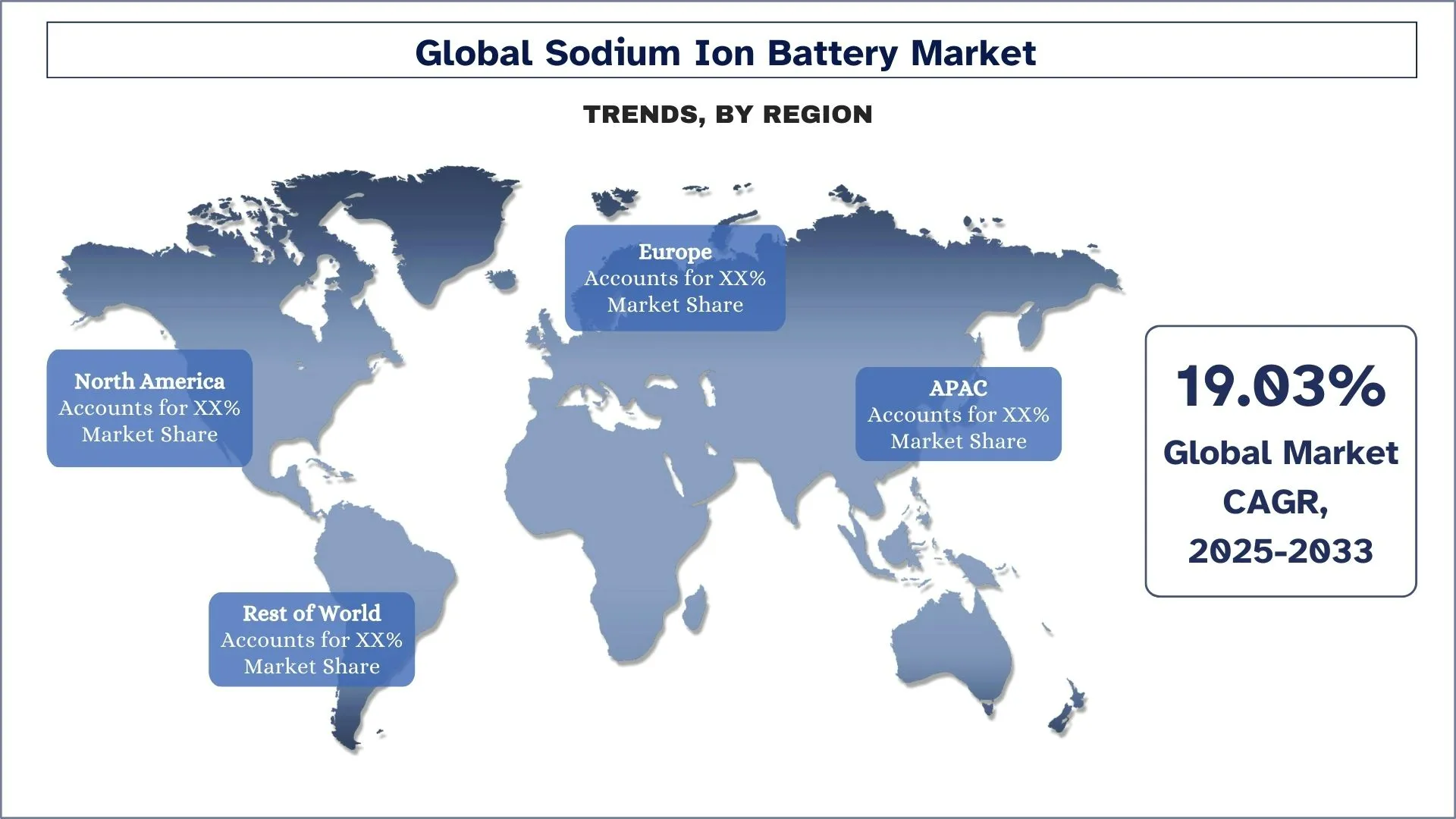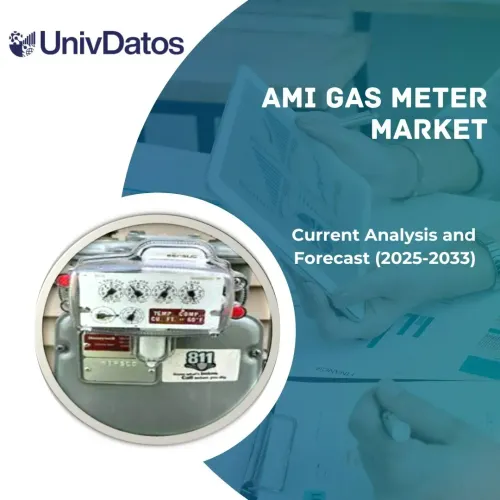- Home
- About Us
- Industry
- Services
- Reading
- Contact Us
Sodium Ion Battery Market: Current Analysis and Forecast (2025-2033)
Emphasis on Type (Sodium-Sulfur Battery, Sodium-Air Battery, and Sodium Salt Battery); End-Use (Utility, Residential, Commercial, Transportation, Industrial, and Others); and Region/Country

Sodium Ion Battery Market Size & Forecast
The sodium ion battery market was valued at approximately USD 689.2 million in 2024 and is expected to grow at a substantial CAGR of around 19.03% during the forecast period (2025-2033), owing to the rising concerns over lithium supply chain constraints and geopolitical dependencies driving the shift toward alternative chemistries.
Sodium-Ion Battery Market Analysis
Sodium-ion batteries are energy storage devices that are based on electrochemical charging & discharging reactions between the cathode and anode. The cathode electrode is generally made up of a sodium-containing layered material. Due to their greater energy storage capacity, reduced price, and increased thermal stability, sodium-ion batteries have recently experienced substantial demand. In addition, sodium-ion batteries are more suited for static applications than Li-ion batteries since they have a similar battery life cycle and energy density. Additionally, the market for sodium-ion batteries is expected to rise in the future due to the rising need for energy and electricity, the increased use of renewable energy sources, and the incorporation of sodium-ion batteries in solar PV panels and wind energy technology.
Sodium-Ion Battery Market Trends
This section discusses the key market trends influencing the various segments of the Sodium Ion Battery market as identified by our research experts.
Increasing investments and collaborations among battery startups and automotive OEMs to commercialize sodium-ion technologies.
The sodium-ion battery market experiences accelerating commercialization due to rising cooperation between battery startups and automotive OEMs and substantial financial investments. Support for sodium-ion technology has risen substantially because companies view it as the next-generation solution to replace lithium-ion batteries, particularly for stationary storage solutions and low-cost mobility applications. Major industry funding flows to startups developing sodium-ion technology alongside automotive companies that establish partnership agreements for obtaining future battery solutions. The collaborations between companies activate research efforts and pilot-scale construction combined with field-based assessments, which accelerate the commercial readiness of sodium-ion batteries.

Sodium Ion Battery Industry Segmentation
This section provides an analysis of the key trends in each segment of the global sodium-ion battery report, along with forecasts at the global, regional, and country levels for 2025-2033.
The Sodium-Sulfur Segment Holds the Largest Share of the Market.
Based on the type, the market is segmented into sodium-sulfur batteries, sodium-air batteries, and sodium-salt batteries. The sodium-sulfur segment is expected to witness significant market growth during the forecast period, owing to its increasing adoption in the electric vehicle segment. Additionally, sodium sulfur batteries are frequently used on the island for high-value applications such as the integration of wind generation and distributed grid assistance since they can operate at higher temperature ranges and offer additional benefits over their counterpart.
The Utility Segment is Expected to Witness a Higher CAGR than the Sodium-Ion Battery Market.
Based on end-use, the market is segmented into utility, residential, commercial, transportation, industrial, and other. The utility segment is expected to register a significant CAGR during the forecast period due to technological advancements attributed to energy storage. Additionally, the adoption of renewable energy and its application for load, thermal stability, and power generation, along with rising energy demand, are likely to drive the market’s expansion. Additionally, the market for sodium-ion batteries for utility applications will be driven by rigorous government regulations to minimize the carbon impact and raise consumer awareness of cleaner fuel.
North America has a significant share of the market in 2024.
The North American sodium-ion battery market serves as a major force among global alternative energy storage solution development initiatives. Business growth, along with price efficiency concerns has led established and startup companies to examine sodium-ion potential for grid storage applications and mobility needs across the region. The region benefits from supportive public policies and local raw material reserves along with strategic investments which establish North America as a crucial center for sodium-ion battery research and commercial progress.
U.S. Dominates the North American Sodium-Ion Battery Market
The U.S. sodium-ion battery sector shows signs of growth because industries require alternative solutions to lithium-ion technology. The pursuit of energy independence, along with sustainable storage, combined with economic performance, has led to significant research into sodium-ion solutions, which now target grid storage backup power and new mobility systems. Various government policies, together with strategic investments and growing research and development initiatives, support the growth of battery manufacturing facilities within the domestic market. U.S. industry leaders accelerate pilot production and infrastructure development to turn the country into an emerging innovation center for sodium-ion batteries.

Sodium-Ion Battery Industry Competitive Landscape
The sodium-ion battery market is competitive, with several global and international players. The key players are adopting different growth strategies to enhance their market presence, such as partnerships, agreements, collaborations, new product launches, geographical expansions, and mergers and acquisitions.
Top Sodium-Ion Battery Companies
Some of the major players operating in the market are AMTE Power Plc, Contemporary Amperex Technology Co., Limited, Nanode Battery Technologies, NGK Insulators, HiNa Battery Technology, Aquion Energy, NEI Corporation, Natron Energy Inc., Reliance Industries, and Altris AB.
Recent Developments in the Sodium-Ion Battery Market
In February 2024, Sodion Energy introduced India's first sodium-ion batteries, marking a significant advancement in energy storage technology. These sodium-ion batteries are poised to revolutionize various sectors, including electric vehicles and home appliances, offering a versatile and sustainable energy storage solution.
In February 2024, Sodion Energy, an Indian company, launched sodium-ion batteries. These newly launched products are used for various applications, including home appliances and EVs.
Sodium Ion Battery Market Report Coverage
Details | |
Base year | 2024 |
Forecast period | 2025-2033 |
Growth momentum | Accelerate at a CAGR of 19.03% |
Market size 2024 | USD 689.2 Million |
Regional analysis | APAC, Europe, Asia-Pacific, Rest of the World |
Major contributing region | North America is expected to grow at the highest CAGR during the forecasted period. |
Key countries covered | U.S., Canada, Germany, France, UK, Spain, Italy, China, Japan, and India |
AMTE Power Plc., Contemporary Amperex Technology Co., Limited, Nanode Battery Technologies, NGK Insulators, HiNa Battery Technology, Aquion Energy, NEI Corporation, Natron Energy Inc., Reliance Industries, and Altris AB. | |
Report Scope | Market Trends, Drivers, and Restraints; Revenue Estimation and Forecast; Segmentation Analysis; Demand and Supply Side Analysis; Competitive Landscape; Company Profiling |
Segments Covered | By Type, By End-Use, By Region/Country |
Reasons to Buy the Sodium Ion Battery Market Report:
The study includes market sizing and forecasting analysis validated by authenticated key industry experts.
The report presents a quick review of overall industry performance at a glance.
The report covers an in-depth analysis of prominent industry peers with a primary focus on key business financials, product portfolios, expansion strategies, and recent developments.
Detailed examination of drivers, restraints, key trends, and opportunities prevailing in the industry.
The study comprehensively covers the market across different segments.
Deep dive regional-level analysis of the industry.
Customization Options:
The global sodium ion battery market can be customized further as per requirements or any other market segment. Besides this, UnivDatos understands that you may have your own business needs; hence, feel free to contact us to get a report that completely suits your requirements.
Table of Content
Research Methodology for Sodium Ion Battery Market Analysis (2023-2033)
We analyzed the historical market, estimated the current market, and forecasted the future market of the global sodium ion battery market to assess its application in major regions worldwide. We conducted exhaustive secondary research to gather historical market data and estimate the current market size. To validate these insights, we carefully reviewed numerous findings and assumptions. Additionally, we conducted in-depth primary interviews with industry experts across the Sodium Ion Battery value chain. After validating market figures through these interviews, we used top-down and bottom-up approaches to forecast the overall market size. We then employed market breakdown and data triangulation methods to estimate and analyze the market size of industry segments and sub-segments.
Market Engineering
We employed data triangulation techniques to finalize the overall market estimation and derive precise statistical numbers for each segment and sub-segment of the global Sodium Ion Battery market. We split the data into several segments and sub-segments by analyzing various parameters and trends, including type, end-use, and regions within the global Sodium Ion Battery market.
The main objective of the Global Sodium Ion Battery Market Study is to
The study identifies current and future trends in the global Sodium Ion Battery market, providing strategic insights for investors. It highlights regional market attractiveness, enabling industry participants to tap into untapped markets and gain a first-mover advantage. Other quantitative goals of the studies include:
Market Size Analysis: Assess the current and forecast market size of the global sodium ion battery market and its segments in terms of value (USD).
Sodium Ion Battery Market Segmentation: The study segments the market by type, end-use, and region.
Regulatory Framework & Value Chain Analysis: Examine the regulatory framework, value chain, customer behavior, and competitive landscape of the Sodium Ion Battery industry.
Regional Analysis: Conduct a detailed regional analysis for key areas such as Asia Pacific, Europe, North America, and the Rest of the World.
Company Profiles & Growth Strategies: Company profiles of the Sodium Ion Battery market and the growth strategies adopted by the market leaders to sustain the fast-growing market.
Frequently Asked Questions FAQs
Q1: What is the sodium-ion battery market's current size and growth potential?
The global sodium ion battery market is valued at approximately USD 689.2 Million in 2024 and is projected to grow at a robust CAGR of 19.03% through 2033.
Q2: What are the driving factors for the growth of the sodium-ion battery market?
The growth of the sodium-ion battery market is primarily driven by concerns over lithium supply chain constraints, geopolitical risks, and the need for more sustainable, cost-effective alternatives to lithium-ion batteries. The push for greener technologies and energy security also plays a significant role.
Q3: Which market has the largest share of the sodium-ion battery market by type?
The sodium-sulfur batteries segment holds the largest share in the sodium-ion battery market. These batteries are favored for their high energy density and suitability for large-scale energy storage, particularly in grid applications and backup power systems.
Q4: What are the major trends in the Sodium Ion Battery market?
A prominent trend in the sodium-ion battery market is the increasing collaboration between battery startups and automotive OEMs to fast-track the commercialization of sodium-ion technologies. These partnerships are advancing innovation, reducing production costs, and accelerating adoption in various sectors.
Q5: Which region will dominate the Sodium Ion Battery market?
North America is currently the dominant region in the sodium-ion battery market, driven by strong investments, government support for clean energy technologies, and the increasing focus on sustainable battery solutions for energy storage and transportation.
Q6: What are the biggest challenges in the Sodium Ion Battery market?
Key challenges in the sodium-ion battery market include limited commercial infrastructure, challenges in scaling manufacturing processes, and the lower energy density of sodium-ion batteries compared to lithium-ion batteries, which limits their application in high-performance electric vehicles.
Q7: Who are the Top players in the global Sodium Ion Battery market?
The leading companies driving innovation in sodium-ion battery include:
• AMTE Power Plc.
• Contemporary Amperex Technology Co., Limited
• Nanode Battery Technologies
• NGK Insulators
• HiNa Battery Technology
• Aquion Energy
• NEI Corporation
• Natron Energy Inc.
• Reliance Industries
• Altris AB
Q8: What are the key application areas driving the adoption of sodium-ion batteries in commercial and industrial sectors?
Sodium-ion batteries are increasingly being adopted in commercial and industrial sectors for grid-scale energy storage, renewable energy integration, and backup power systems. Their scalability, cost-efficiency, and thermal stability make them a compelling alternative for large-scale, stationary energy storage, especially where energy density is less critical than with lithium-ion batteries.
Q9: How can battery manufacturers and tech investors capitalize on the emerging sodium-ion battery market?
Battery manufacturers and investors can capitalize on the growing sodium-ion battery market by investing in R&D and forming strategic partnerships with startups. Key opportunities include developing scalable production infrastructures, supporting pilot projects, and expanding into underserved markets that demand low-cost, sustainable energy solutions, such as grid storage and low-speed electric mobility applications.
Related Reports
Customers who bought this item also bought










